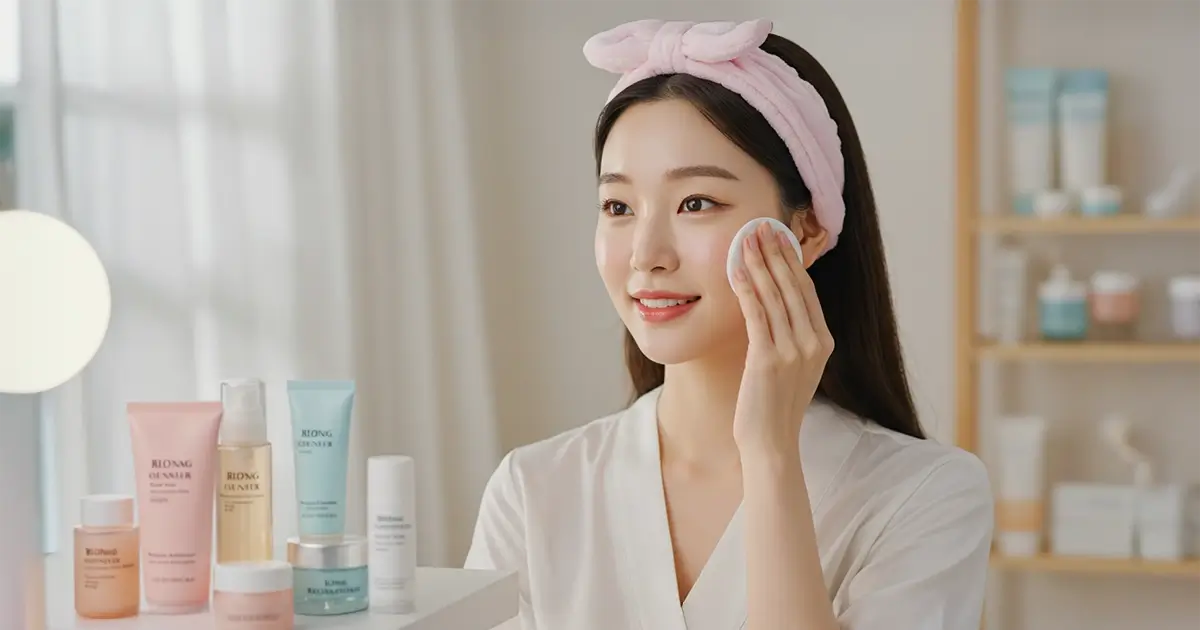Curious how the legendary Korean ten-step routine can teach us to do more with less? I break down each traditional layer, then show you how to trim the excess, all in one friendly 9-minute read.
From Seoul to Your Sink: The Rise of the Ten Steps
K-Beauty exploded in the late 2010s, powered by social media and a devotion to gentle, layered hydration that challenged the West's "scrub it clean" approach. The method promised calmer, bouncier skin without prescription prices.
Under the hype sits a cultural philosophy: respect the barrier, add water back before sealing it in, and treat skin as an organ that likes steady nourishment, not shocks. That mindset resonated with anyone tired of "one-and-done" quick fixes.
A recent observational study followed everyday users of multistep routines and found improved adherence and satisfaction compared with single-product habits (NCBI, 2024). Translation: people stuck with it because their faces felt better.
The Classic Ten, One Step at a Time
1. Oil Cleanser
Think of this as makeup's gentle exit strategy. Plant-based oils bind to sunscreen, foundation, and sebum so you can rinse them all away without stripping your lipid layer.
2. Water-Based Cleanser
A low-pH gel sweeps off sweat and dust left behind. Pick a formula that foams softly instead of one that crackles like dish soap.
3. Exfoliant
Whether it is lactic acid or a rice powder polish, this step loosens dull surface cells. Limit to two nights a week if your cheeks turn pink easily.
4. Toner
Forget the astringent of the 90s. Modern Korean toners deliver humectants - glycerin, panthenol - setting a moist stage for what follows.
5. Essence
Lighter than serum, heavier than toner, essences usually carry fermented ingredients that nudge cell renewal. One swipe, no need to drench cotton pads.
6. Serum or Ampoule
This is the power seat. Vitamin C for brightness, peptides for firmness, or niacinamide for oil control - tailor it to your main concern.
7. Sheet Mask
Hydrogel or thin cotton sheets lock in active ingredients for fifteen breezy minutes. Spoiler: your bathroom shelf will not file a complaint if you skip the mask on a Wednesday.
8. Eye Cream
The thinner under-eye skin appreciates peptides and ceramides in a non-fragranced base. Dab gently; no tug-of-war with crow's-feet.
9. Moisturizer
Occlusive creams seal earlier humectants. A Harvard Health explainer reminds us that the main job is trapping water, not adding it, so apply while skin is still slightly damp.
10. Sunscreen
Broad-spectrum SPF 30 or higher is the non-negotiable daytime finale. Mayo Clinic dermatologists advise reapplying every two hours outside and sticking with SPF 30 indoors if you sit by sunny windows (Mayo Clinic, 2024).
Streamlining without Sacrificing Results
Modern minimalists crave clarity, not clutter, so I consolidate overlapping roles. Oil plus water cleansers become a single low-pH balm, and essence merges with toner in a hydrating "skin mist."
Here is a four-step evening plan that still follows the Korean logic:
- Gentle balm cleanser
- Hydrating toner-essence hybrid
- Targeted active serum
- Ceramide-rich cream
Need morning inspiration? My earlier post on a minimalist five-product routine pairs perfectly with these tweaks.
Pitfalls to Watch Out For
Over-exfoliation shows up as stingy redness and tiny bumps. When that happens, put the acids on vacation and hydrate like it is your job.
Skipping moisturizer because skin feels oily can backfire, leading to more sebum as barriers cry for help. Lightweight gels still count as moisturizers.
Many people forget neck and ears when applying SPF. Those areas age just as fast, so spread the sunscreen love evenly.
Science-Backed Heroes Worth Keeping
Niacinamide at 5 percent calms redness and balances oil, making it a multitasker worth permanent residency in any routine.
Ceramides strengthen tight junctions, reducing water loss. They shine in climates that swing from steamy afternoons to air-conditioned evenings.
And, yes, daily SPF remains the top proven anti-aging habit, beating most fancy actives combined - because UV damage never takes a holiday.
FAQ
Is the ten-step routine necessary every day?
No. Use it as a toolbox. Pick what your skin needs that morning or night, rather than marching through all ten.
Can I mix Western and Korean products?
Absolutely. Compatibility lies in pH, texture, and active strength, not in the brand's postal code.
What order should I apply products if I skip a step?
Go from thinnest to thickest texture: cleanse, hydrate, treat, seal, protect.
How long should I wait between steps?
Thirty seconds, or until the previous layer no longer feels wet, is plenty for most formulas.
Is sunscreen really needed indoors?
Yes if sunlight pours through windows or you work beside large screens that emit some high-energy visible light.
Do sheet masks make a big difference?
They provide a short-term hydration boost. Great before events, optional on rushed nights.
Conclusion
The ten-step routine earned fame by layering hydration and protection, but its true lesson is flexibility. Use the steps as modular pieces to suit your time, budget, and skin mood.
Share your own tweaks in the comments, and let me know which step you never skip. See you in the next post - until then, take good care of your skin!


Comments (0)
No comments yet - be the first to share your thoughts!
Leave a Reply
Your email address will not be published. Required fields are marked *